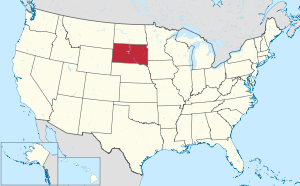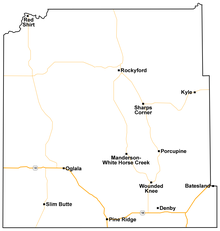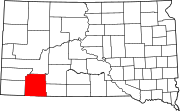County in South Dakota
| Oglala Lakota County | |
|---|---|
| County | |
 Indian Health Service Hospital in Pine Ridge on the Pine Ridge Indian Reservation, November 2011 Indian Health Service Hospital in Pine Ridge on the Pine Ridge Indian Reservation, November 2011 | |
 Location within the U.S. state of South Dakota Location within the U.S. state of South Dakota | |
 South Dakota's location within the U.S. South Dakota's location within the U.S. | |
| Coordinates: 43°20′N 102°33′W / 43.33°N 102.55°W / 43.33; -102.55 | |
| Country | |
| State | |
| Founded | 1875 |
| Named for | Oglala Lakota people |
| Seat | None (de jure) Hot Springs (de facto) |
| Largest community | Pine Ridge |
| Area | |
| • Total | 2,097 sq mi (5,430 km) |
| • Land | 2,094 sq mi (5,420 km) |
| • Water | 2.8 sq mi (7 km) 0.1% |
| Population | |
| • Total | 13,672 |
| • Estimate | 13,434 |
| • Density | 6.5/sq mi (2.5/km) |
| Time zone | UTC−7 (Mountain) |
| • Summer (DST) | UTC−6 (MDT) |
| Congressional district | At-large |
| Website | oglalalakota |
| Hot Springs in neighboring Fall River County serves as administrative center for county | |
Oglala Lakota County (known as Shannon County until May 2015) is a county in southwestern South Dakota, United States. As of the 2020 census, the population was 13,672. Oglala Lakota County does not have a functioning county seat; Hot Springs in neighboring Fall River County serves as its administrative center. The county was created as a part of the Dakota Territory in 1875, although it remains unorganized. Its largest community is Pine Ridge.
The county lies entirely within the Pine Ridge Indian Reservation and contains part of Badlands National Park. It is one of five South Dakota counties entirely on an Indian reservation.
The county is named after the Oglala Lakota, a band of the Lakota people. Many of the county's inhabitants are members of this sub-tribe.
Reservation poverty affects the county, which is the poorest county in the United States (only 28 county-equivalents in the U.S. territories are poorer). Oglala Lakota County is the only dry county in South Dakota.
The newspaper for Oglala Lakota County is The Lakota Country Times.
History
The Wounded Knee Massacre occurred in Oglala Lakota County in 1890.
The county was originally named for Peter C. Shannon, Chief Justice of the Dakota Territory Supreme Court. Until 1982, Shannon County and Washabaugh County, South Dakota, were the last unorganized counties in the United States. Although it was organized and received a home rule charter that year, the county, as noted above, contracts with Fall River County for its Auditor, Treasurer, and Registrar of Deeds.
On November 4, 2014, voters in the county voted by a margin of 2,161 to 526 to rename Shannon County to Oglala Lakota County. The name change was ratified by the state legislature on March 5, 2015. May 1, 2015 was proclaimed by the governor as the official day for renaming the county.
Geography

Oglala Lakota County lies on the south side of South Dakota. Its south boundary line abuts the north boundary line of the state of Nebraska. The Cheyenne River flows northeastward along the northwest boundary of Oglala Lakota County. The White River flows northeastward through the central part of the county. The county terrain is composed of semi-arid rolling hills spotted with small mountain crests, oriented NE-SW. The terrain slopes to the northeast; its highest point is on the south boundary line, close to the SW corner, at 3,619 ft (1,103 m) ASL. The county has a total area of 2,097 square miles (5,430 km), of which 2,094 square miles (5,420 km) is land and 2.8 square miles (7.3 km) (0.1%) is water.
The county includes the headwaters of the Little White River.
Major highways
Adjacent counties
- Pennington County - north
- Jackson County - northeast
- Bennett County - east
- Sheridan County, Nebraska - south
- Dawes County, Nebraska - southwest
- Fall River County - west
- Custer County - northwest
National protected area
- Badlands National Park (part)
Lakes
- Alkali Lake
- Denby Lake
- Lee Lake
- Oglala Lake
- Two Lance Lake
- Wakpamani Lake
- White Clay Lake
Source:
Demographics
| Census | Pop. | Note | %± |
|---|---|---|---|
| 1920 | 2,003 | — | |
| 1930 | 4,058 | 102.6% | |
| 1940 | 5,366 | 32.2% | |
| 1950 | 5,669 | 5.6% | |
| 1960 | 6,000 | 5.8% | |
| 1970 | 8,198 | 36.6% | |
| 1980 | 11,323 | 38.1% | |
| 1990 | 9,902 | −12.5% | |
| 2000 | 12,466 | 25.9% | |
| 2010 | 13,586 | 9.0% | |
| 2020 | 13,672 | 0.6% | |
| 2023 (est.) | 13,434 | −1.7% | |
| U.S. Decennial Census 1790-1960 1900-1990 1990-2000 2010-2020 | |||
2020 census
As of the 2020 census, there were 13,672 people, 3,208 households, and 2,488 families residing in the county. The population density was 6.5 inhabitants per square mile (2.5/km). There were 3,454 housing units.
2000 census
As of the 2000 census, there were 12,466 people, 2,785 households, and 2,353 families residing in the county. The population density was 6 people per square mile (2.3 people/km). There were 3,123 housing units at an average density of 2 per square mile (0.77/km). The racial makeup of the county was 4.51% White, 0.08% Black or African American, 94.20% American Indian, 0.02% Asian, 0.05% Pacific Islander, 0.22% from other races, and 0.91% from two or more races. Hispanic or Latino of any race were 1.42% of the population.
There were 2,785 households, out of which 51.70% had children under the age of 18 living with them, 35.40% were married couples living together, 36.40% had a female householder with no husband present, and 15.50% were non-families. 13.20% of all households were made up of individuals, and 3.00% had someone living alone who was 65 years of age or older. The average household size was 4.36 and the average family size was 4.72.
The county population contained 45.30% under the age of 18, 10.60% from 18 to 24, 25.60% from 25 to 44, 13.80% from 45 to 64, and 4.80% who were 65 years of age or older. The median age was 21 years. For every 100 females there were 99.60 males. For every 100 females age 18 and over, there were 95.60 males.
The median income for a household in the county was $20,916, and the median income for a family was $20,897. Males had a median income of $25,170 versus $22,594 for females. The per capita income for the county was $6,286. About 45.10% of families and 52.30% of the population were below the poverty line, including 60.80% of those under age 18 and 36.00% of those age 65 or over.
Health and life expectancy
Of 3,142 counties in the United States in 2014, Oglala Lakota County ranked last in the life expectancy of both male and female residents. Males in Oglala Lakota County lived an average of 62.8 years and females lived an average of 71.0 years compared to the national average for life expectancy of 76.7 for males and 81.5 for females. The average life expectancy in Oglala Lakota County increased by 6.2 for males and 4.1 years for females between 1980 and 2014, compared to an increase in the national average for the same period of an increased life span of 6.7 years for men and 3.9 years for women.
In 2021, the Robert Wood Johnson Foundation ranked Oglala Lakota County last of 61 counties in South Dakota in "health outcomes," as measured by length and quality of life.
Politics
The counties surrounding Oglala Lakota County are predominantly Republican, but, like most Native American counties, residents of Oglala Lakota are mostly Democrats, giving over 75 percent of the vote to every Democratic presidential nominee in every election back to 1984, making it one of the most Democratic counties in the United States. No Republican has carried the county in a presidential election since 1952. In 2012, Oglala Lakota County (then known as Shannon) was the county with the highest percentage of vote for Barack Obama in the United States. However, the local politics are a bit more divided: Oglala Lakota County lies within the 27th District of the South Dakota Legislature, represented by three Lakotas, two Democrats and one Republican. Democrat Red Dawn Foster represents the county in the Senate, while Democrat Peri Pourier and Republican Liz Marty May represents the county in the House.
| Year | Republican | Democratic | Third party(ies) | |||
|---|---|---|---|---|---|---|
| No. | % | No. | % | No. | % | |
| 2024 | 406 | 13.26% | 2,567 | 83.83% | 89 | 2.91% |
| 2020 | 297 | 9.28% | 2,829 | 88.41% | 74 | 2.31% |
| 2016 | 241 | 8.30% | 2,510 | 86.40% | 154 | 5.30% |
| 2012 | 188 | 5.98% | 2,937 | 93.39% | 20 | 0.64% |
| 2008 | 331 | 9.88% | 2,971 | 88.69% | 48 | 1.43% |
| 2004 | 526 | 12.48% | 3,566 | 84.62% | 122 | 2.90% |
| 2000 | 252 | 12.90% | 1,667 | 85.36% | 34 | 1.74% |
| 1996 | 253 | 11.08% | 1,926 | 84.33% | 105 | 4.60% |
| 1992 | 225 | 13.63% | 1,267 | 76.74% | 159 | 9.63% |
| 1988 | 256 | 17.31% | 1,206 | 81.54% | 17 | 1.15% |
| 1984 | 324 | 17.71% | 1,489 | 81.41% | 16 | 0.87% |
| 1980 | 438 | 25.96% | 1,132 | 67.10% | 117 | 6.94% |
| 1976 | 301 | 27.84% | 756 | 69.94% | 24 | 2.22% |
| 1972 | 356 | 22.10% | 1,246 | 77.34% | 9 | 0.56% |
| 1968 | 533 | 29.68% | 1,202 | 66.93% | 61 | 3.40% |
| 1964 | 557 | 24.16% | 1,748 | 75.84% | 0 | 0.00% |
| 1960 | 655 | 36.59% | 1,135 | 63.41% | 0 | 0.00% |
| 1956 | 782 | 45.18% | 949 | 54.82% | 0 | 0.00% |
| 1952 | 957 | 55.29% | 774 | 44.71% | 0 | 0.00% |
| 1948 | 641 | 44.09% | 803 | 55.23% | 10 | 0.69% |
| 1944 | 562 | 53.93% | 480 | 46.07% | 0 | 0.00% |
| 1940 | 1,094 | 58.04% | 791 | 41.96% | 0 | 0.00% |
| 1936 | 667 | 49.93% | 634 | 47.46% | 35 | 2.62% |
| 1932 | 463 | 36.69% | 798 | 63.23% | 1 | 0.08% |
| 1928 | 469 | 43.63% | 601 | 55.91% | 5 | 0.47% |
| 1924 | 992 | 88.89% | 76 | 6.81% | 48 | 4.30% |
Communities
Town
Census-designated places
Unincorporated communities
Townships
There are no townships. The county is divided into two areas of unorganized territory: East Oglala Lakota and West Oglala Lakota (formerly East Shannon and West Shannon, respectively).
See also
- List of counties in South Dakota
- National Register of Historic Places listings in Oglala Lakota County, South Dakota
References
- ^ "Oglala Lakota County, South Dakota". oglalalakota.sdcounties.org. Oglala Lakota County. Retrieved October 22, 2019.
- "Oglala Lakota County, South Dakota: About". oglalalakota.sdcounties.org. Oglala Lakota County. Retrieved October 22, 2019.
- ^ "State & County QuickFacts". United States Census Bureau. Retrieved March 21, 2024.
- "Dakota Territory, South Dakota, and North Dakota: Individual County Chronologies". Dakota Territory Atlas of Historical County Boundaries. The Newberry Library. 2006. Archived from the original on April 2, 2018. Retrieved March 30, 2015.
- "South Dakota Legislative Manual" (PDF). South Dakota Secretary of State. 2005. p. 597. Archived from the original (PDF) on March 29, 2015. Retrieved March 30, 2015.
- The other four SD counties entirely on reservations are Corson, Dewey, Todd, and Ziebach.
- "The Lakota Country Times". Lakota Country Times.
- "Martin Lakota Country Times". South Dakota Newspaper Association. Retrieved April 10, 2016.
- "Oglala Lakota (Shannon) County, South Dakota: History". www.e-referencedesk.com. Archived from the original on March 1, 2012. Retrieved April 15, 2018.
- Montgomery, David (November 5, 2014). "Shannon County no more: Voters approve name change". Argus Leader. Retrieved April 27, 2024.
- Mercer, Bob (March 5, 2015). "It's official: Oglala Lakota County replaces Shannon County Name". Rapid City Journal. Retrieved March 14, 2015.
- "Governor's Executive Proclamation". Office of the Governor.
- ^ Shannon County SD Google Maps (accessed February 7, 2019)
- ""Find an Altitude" Google Maps (accessed February 7, 2019)". Archived from the original on May 21, 2019. Retrieved February 8, 2019.
- "2010 Census Gazetteer Files". United States Census Bureau. August 22, 2012. Retrieved March 28, 2015.
- "County Population Totals and Components of Change: 2020-2023". Retrieved March 17, 2024.
- "U.S. Decennial Census". United States Census Bureau. Retrieved March 28, 2015.
- "Historical Census Browser". University of Virginia Library. Retrieved March 28, 2015.
- Forstall, Richard L., ed. (March 27, 1995). "Population of Counties by Decennial Census: 1900 to 1990". United States Census Bureau. Retrieved March 28, 2015.
- "Census 2000 PHC-T-4. Ranking Tables for Counties: 1990 and 2000" (PDF). United States Census Bureau. April 2, 2001. Archived (PDF) from the original on October 9, 2022. Retrieved March 28, 2015.
- "US Census Bureau, Table P16: Household Type". United States Census Bureau. Retrieved March 21, 2024.
- "Oglala Lakota County, South Dakota" (PDF). Institute for Health Metrics and Evaluation. University of Washington. Archived (PDF) from the original on October 9, 2022. Retrieved April 12, 2022.
- "U.S. Health Map". Institute for Health Metrics and Evaluation. University of Washington. Retrieved April 12, 2022.
- "2021 South Dakota Report". Robert Wood Johnson Foundation. Retrieved April 12, 2022.
- "David Leip's Presidential Election Atlas – 2012 statistics". Uselectionatlas.org. Retrieved November 6, 2019.
- Leip, David. "Atlas of US Presidential Elections". uselectionatlas.org. Retrieved December 4, 2020.
External links
| Places adjacent to Oglala Lakota County, South Dakota | ||||||||||||||||
|---|---|---|---|---|---|---|---|---|---|---|---|---|---|---|---|---|
| ||||||||||||||||
| Municipalities and communities of Oglala Lakota County, South Dakota, United States | ||
|---|---|---|
| County seat: Hot Springs | ||
| Town |  | |
| CDPs | ||
| Unincorporated communities | ||
| Indian reservation | ||
| Footnotes | ‡This populated place also has portions in an adjacent county or counties | |